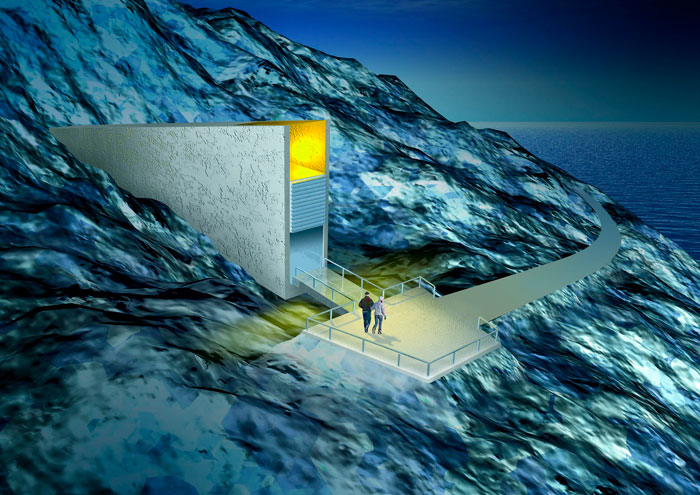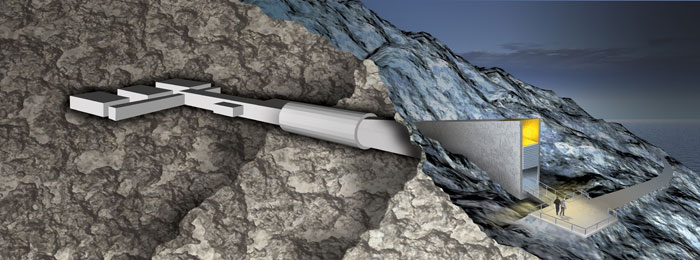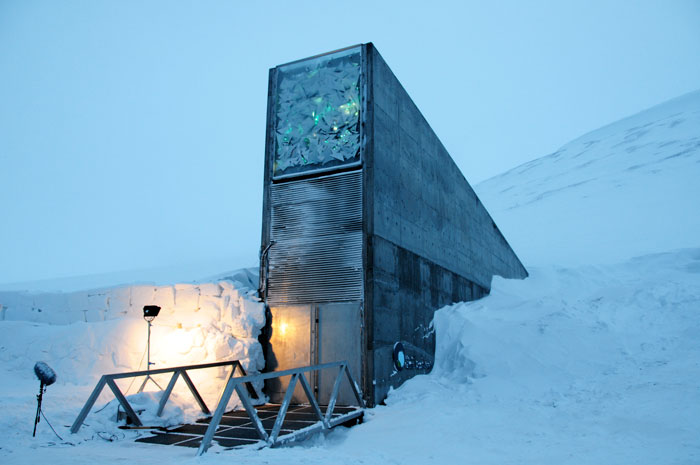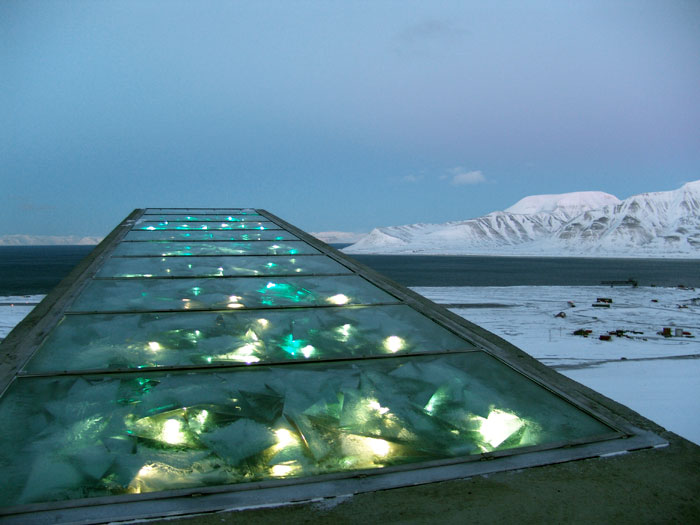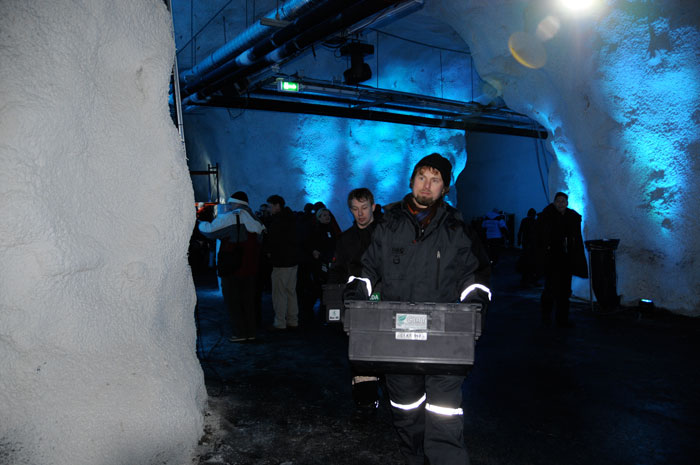|
|
||||
|
..
Illustration: Global Crop Diversity Trust Bill Gates, Rockefeller and the
GMO giants know something we don’t
Excerpt: No project is more interesting at the moment than a curious project in one of the world’s most remote spots, Svalbard. Bill Gates is investing millions in a seed bank on the Barents Sea near the Arctic Ocean, some 1,100 kilometers from the North Pole. Svalbard is a barren piece of rock claimed by Norway and ceded in 1925 by international treaty Excerpt: The seed bank is being built inside a mountain on Spitsbergen Island near the small village of Longyearbyen. It’s almost ready for ‘business’ according to their releases. The bank will have dual blast-proof doors with motion sensors, two airlocks, and walls of steel-reinforced concrete one meter thick. It will contain up to three million different varieties of seeds from the entire world, ‘so that crop diversity can be conserved for the future,’ according to the Norwegian government. Seeds will be specially wrapped to exclude moisture. There will be no full-time staff, but the vault's relative inaccessibility will facilitate monitoring any possible human activity. Did we miss something here? Their press release stated, ‘so that crop diversity can be conserved for the future.’ What future do the seed bank’s sponsors foresee, that would threaten the global availability of current seeds, almost all of which are already well protected in designated seed banks around the world? Anytime Bill Gates, the Rockefeller Foundation, Monsanto and Syngenta get together on a common project, it’s worth digging a bit deeper behind the rocks on Spitsbergen. When we do we find some fascinating things. The first notable point is who is sponsoring the doomsday seed vault. Here joining the Norwegians are, as noted, the Bill & Melinda Gates Foundation; the US agribusiness giant DuPont/Pioneer Hi-Bred, one of the world’s largest owners of patented genetically-modified (GMO) plant seeds and related agrichemicals; Syngenta, the Swiss-based major GMO seed and agrichemicals company through its Syngenta Foundation; the Rockefeller Foundation, the private group who created the “gene revolution with over $100 million of seed money since the 1970’s; CGIAR, the global network created by the Rockefeller Foundation to promote its ideal of genetic purity through agriculture change. Read the full story.... SOURCE: Global Research |
||||
|
..
November 16, 2007 | 11:16:35 AM Wired Science Catastrophic climate change, nuclear war, asteroid strikes: no matter what happens to our planet, the Svalbard Global Seed Vault will deliver its vast seed collection to Earth's plucky survivors, potentially jump-starting the rebirth of civilization. Wired covered the Vault last may, and the BBC reports that engineers just started the two-month cooldown required to bring the mountain-core facility to a seed-friendly zero degrees. The first seed delivery is scheduled for mid-February. Hopefully it will never be needed. But just imagine if it is: agriculture was born in the Fertile Crescent, and would be resurrected on an icebound island halfway between Norway and the North Pole. There's something poetic about that. Doomsday vault begins deep freeze [BBC] Ultimate
Crop Backup System [Wired]
|
||||
Related Links and Sources:
|
||||
|
..
out ofan Arctic mountainside in the Svalbard archipelago. Photo Credit: Mari Tefre/Global Crop Diversity Trust Millions of vital crop seeds
will be buried deep within the frozen earth of Svalbard
Excerpt: A barren, treeless island in the Arctic archipelago of Svalbard may prove to be the last, best hope of agriculture in warmer, more fertile parts of the world. The first batch of 100 million of the most important agricultural seeds were placed into the doomsday repository there today. The Svalbard Global Seed Vault is buried deep within a frozen mountainside near the Norwegian town of Longyearbyen that perpetually cools it to –18 degrees Celsius (–0.4 degree Fahrenheit) with or without permafrost. Built to withstand all foreseeable disasters, including a recent earthquake that was the biggest in Norwegian history, it has room to protect at least 4.5 million samples (2.25 billion seeds) in its three man-made caverns. "The opening of the seed vault marks a historic turning point in safeguarding the world's crop diversity," says Cary Fowler, executive director of the Rome-based Global Crop Diversity Trust, which led the project. "Crop diversity will soon prove to be our most potent and indispensable resource for addressing climate change, water and energy supply constraints, and for meeting the food needs of a growing population." SOURCE: Scientific American |
||||
The Structure The Svalbard Global Seed Vault is the ultimate protection for the world’s agricultural biodiversity, and will therefore be built to stand the test of time. Put simply, a tunnel will be excavated in the side of a mountain. The facility will have one entrance and a robust security door and airlock will separate the entrance area from the seed vault itself.
In order to maintain the temperature at a constant -10°C to -20°C, the cold Arctic air will be drawn into the vault during the winter, automatically and without human intervention. The surrounding rock will maintain the temperature requirements during the extremely cold season and during warmer periods refrigeration equipment will engage. However, in the event of an equipment failure, temperatures in the vault would not rise above approximately -3.5°C, and would, in fact, take months to warm even to that level which would be perfectly adequate for seed conservation for some years. The inside of the seed storage vault will be lined with insulated panels (in addition to the thick concrete wall) to help maintain the cold temperatures. Electronic transmitters linked to a satellite system will monitor temperature, etc., and send this information back to the appropriate authorities at Longyearbyen and at the Nordic Gene Bank, which will provide the technical expertise for managing the Seed Vault.
Photo Credit: Mari Tefre/Global Crop Diversity Trust Saving Seeds at Svalbard The Seed Vault has a capacity of 4.5 million seed samples, equivalent to about 2 billion seeds. Samples eligible for conservation at Svalbard must already be housed in two conventional long-term genebanks elsewhere, in keeping with current international standards. The facility will start with a collection from the CGIAR and certain key national genebanks. As the collection expands, the focus will be on safeguarding as much of the world’s unique genetic material as possible and avoiding duplication.
Photo Credit: Mari Tefre/Global Crop Diversity Trust Seed would be stored under what
is known as “black box” arrangements, meaning that seed packages and boxes
sent for storage would not be opened. The responsibility for testing material
or for subsequent regeneration and multiplication will remain with the
genebanks sending their seeds to Svalbard. The Svalbard Global Seed Vault
will not operate like a regular genebank, making material available to
breeders, and in fact samples held in “black boxes” will only be released
in the event that all other seed sources have been destroyed or exhausted.
|
||||
|
..
The Svalbard Global Seed Vault, or the Doomsday Vault as the media have nicknamed it, will be the ultimate safety net for the world’s most important natural resource. Permafrost and thick rock will ensure that even without electricity, the samples will remain frozen. The vault’s construction has been funded by the Norwegian government as a service to the world community. The Global Crop Diversity Trust considers the vault an essential component of a rational and secure global system for conserving the diversity of all our crops. The Trust is therefore committed to supporting ongoing operational costs, and is assisting developing countries with preparing, packaging and transporting their representative seeds to the Arctic. The remote location, as well as the rugged structure, provide unparalleled security for the world’s agricultural heritage, and the facility will also be equipped with motion detectors and possibly even CCTV. The presence of polar bears, which prowl the area, may be seen by some as providing an added layer of security. The Seed Vault, with its combination of natural and mechanical cooling systems and remote location, is designed to provide a service that no genebank or even consortium of genebanks can offer, and which will function effectively centuries into the future. SOURCE: Croptrust.org |
||||
| FAIR USE NOTICE: This page contains copyrighted material the use of which has not been specifically authorized by the copyright owner. Pegasus Research Consortium distributes this material without profit to those who have expressed a prior interest in receiving the included information for research and educational purposes. We believe this constitutes a fair use of any such copyrighted material as provided for in 17 U.S.C § 107. If you wish to use copyrighted material from this site for purposes of your own that go beyond fair use, you must obtain permission from the copyright owner. | ||||
|
|
